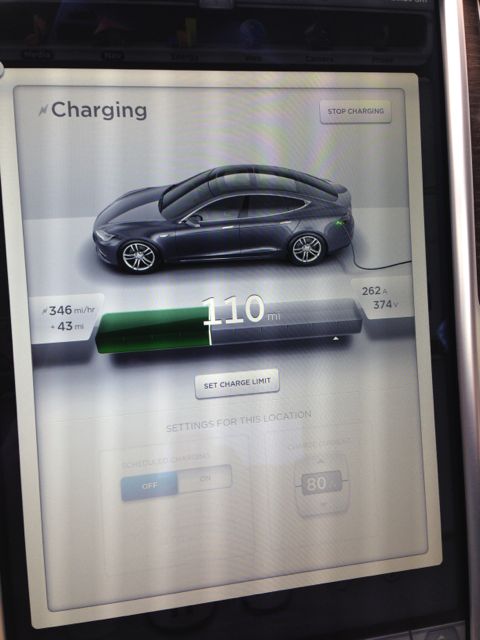Tesla Model S
How to use a Tesla Supercharger and what to expect
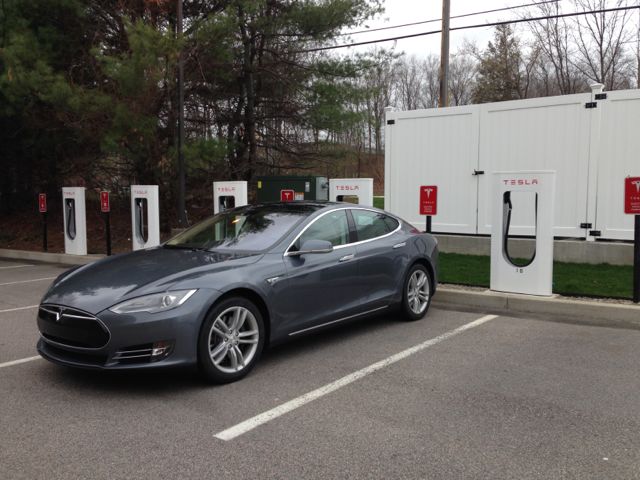
Today I had to drop off my mother-in-law at Providence airport and I used it as an excuse to make my first Tesla Supercharger visit at the East Greenwich, RI Supercharger. This is currently the northern-most Supercharger on the east coast in the US and located 10 minutes south of Providence Airport (PVD).
I decided not to charge up the night before and left my Model S with 127 miles of range on it. With that amount of range I would have enough to get to the airport, drive to the Supercharger and still drive home if for some reason the Supercharger didn’t work.
Connecting to the Tesla Supercharger
 Superchargers appear to have different layouts depending on the location, some you back into while others require you to pull forward – this one is the former. You’ll want to be pretty close to the Supercharger since the cable is relatively short. The charger will always need to be to the left side of the car since that’s where the charge port door is. The rear view camera helps a ton and combined with the parking sensors really allow you to get close without being too close. I love how the parking sensor displays your proximity measurements (in inches for the US).
Superchargers appear to have different layouts depending on the location, some you back into while others require you to pull forward – this one is the former. You’ll want to be pretty close to the Supercharger since the cable is relatively short. The charger will always need to be to the left side of the car since that’s where the charge port door is. The rear view camera helps a ton and combined with the parking sensors really allow you to get close without being too close. I love how the parking sensor displays your proximity measurements (in inches for the US).
Once parked and situated you’ll want to pop open the charge port and insert the thick Supercharger cable. I had some difficulties with this at first and encountered a red ring indicating that there was a bad connection.
I pushed the handle in with a bit more force and noticed the red indicator light started to pulsate in green. The center touchscreen read “Preparing for charge” and so I waited. To my surprise the next message popped up and said “unable to charge” so I got out of the car, unplugged the cable and firmly reseated it once more. I waited through the same preparation phase until the car finally began to start charging.
I’ve heard from other owners that Tesla Supercharger connections can be a bit finicky at times so if you don’t succeed at first, try again before moving onto another charging bay.
Supercharger Charging Sequence
Once you’ve successfully made it past the charge preparation sequence, the car will indicate that it’s starting to charge and display the voltage and amperage in which you’re charging at. It takes a few seconds before it ramps up to its peak charge rate which for me read 346 miles/hour at 262A/374V. The peak rate of charge will vary depending on whether its the older 90kW or newer 120kW Superchargers.
Supercharging
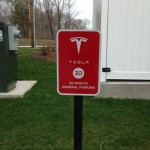 I explored the shopping center where the Supercharger station was located. In fact the Supercharger bays at this location was simply eight additional parking spots slotted next to a Walgreens. There’s also an Outback, Ruby Tuesdays, Panera and McDonalds in the area all within walking distance. I decided to go into Panera for a warm drink. It was 40 degrees and approaching May – welcome to New England.
I explored the shopping center where the Supercharger station was located. In fact the Supercharger bays at this location was simply eight additional parking spots slotted next to a Walgreens. There’s also an Outback, Ruby Tuesdays, Panera and McDonalds in the area all within walking distance. I decided to go into Panera for a warm drink. It was 40 degrees and approaching May – welcome to New England.
Another thing I noticed at the location is that 5 slots are marked for “Tesla Electric Vehicle” whereas the other 3 are marked for general parking 30 minutes. While I was sitting there waiting for my charge, a Walgreens customer took advantage of the 30 minute parking rule for a brief moment, but otherwise the slots were all open for Tesla owners. New England still ranks pretty low in terms of Tesla ownership per capita.
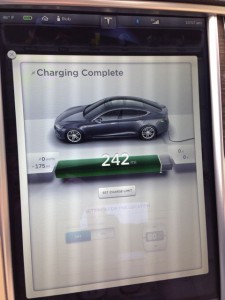 My charge finished at exactly 50 minutes taking me from 67 miles of rated range to 242 miles of rated range at a 90% state of charge. This equated to 175 miles of charge in 50 minutes. My understanding of the rate of charge can go even higher when you start your charge from near-zero but i’d have a serious case of range anxiety if I did that.
My charge finished at exactly 50 minutes taking me from 67 miles of rated range to 242 miles of rated range at a 90% state of charge. This equated to 175 miles of charge in 50 minutes. My understanding of the rate of charge can go even higher when you start your charge from near-zero but i’d have a serious case of range anxiety if I did that.
All the displays on the car through the process were great. The one thing I wish they did was give you an estimated time to charge complete. The calculation isn’t simple since they’re varying charge over time, it depends on the state of the Supercharger, if the bay next to you is empty, etc. If it would pop up and say “You’ve got about 45 minutes to do something else” it would have been more helpful. I’m sure some smart people at Tesla can figure out how to do that.
In the end, I got 175 miles of range for free and the experience was great. Now all I need is an excuse to take an extended Supercharger road trip!

News
Tesla shocks with latest Robotaxi testing move
Why Tesla has chosen to use a couple of Model S units must have a reason; the company is calculated in its engineering and data collection efforts, so this is definitely more than “we just felt like giving our drivers a change of scenery.”

Tesla Model S vehicles were spotted performing validation testing with LiDAR rigs in California today, a pretty big switch-up compared to what we are used to seeing on the roads.
Tesla utilizes the Model Y crossover for its Robotaxi fleet. It is adequately sized, the most popular vehicle in its lineup, and is suitable for a wide variety of applications. It provides enough luxury for a single rider, but enough room for several passengers, if needed.
However, the testing has seemingly expanded to one of Tesla’s premium flagship offerings, as the Model S was spotted with the validation equipment that is seen entirely with Model Y vehicles. We have written several articles on Robotaxi testing mules being spotted across the United States, but this is a first:
🚨 Tesla is using Model S vehicles fitted with LiDAR rigs to validate FSD and Robotaxi, differing from the Model Ys that it uses typically
Those Model Y vehicles have been on the East Coast for some time. These Model S cars were spotted in California https://t.co/CN9Bw5Wma8 pic.twitter.com/UE55hx5mdd
— TESLARATI (@Teslarati) December 11, 2025
Why Tesla has chosen to use a couple of Model S units must have a reason; the company is calculated in its engineering and data collection efforts, so this is definitely more than “we just felt like giving our drivers a change of scenery.”
It seems to hint that Tesla could add a premium, more luxury offering to its Robotaxi platform eventually. Think about it: Uber has Uber Black, Lyft has Lyft Black. These vehicles and services are associated with a more premium cost as they combine luxury models with more catered transportation options.
Tesla could be testing the waters here, and it could be thinking of adding the Model S to its fleet of ride-hailing vehicles.
Reluctant to remove the Model S from its production plans completely despite its low volume contributions to the overall mission of transitioning the world to sustainable energy, the flagship sedan has always meant something. CEO Elon Musk referred to it, along with its sibling Model X, as continuing on production lines due to “sentimental reasons.”
However, its purpose might have been expanded to justify keeping it around, and why not? It is a cozy, premium offering, and it would be great for those who want a little more luxury and are willing to pay a few extra dollars.
Of course, none of this is even close to confirmed. However, it is reasonable to speculate that the Model S could be a potential addition to the Robotaxi fleet. It’s capable of all the same things the Model Y is, but with more luxuriousness, and it could be the perfect addition to the futuristic fleet.
News
Tesla Model S makes TIME’s list of Best Inventions

Tesla’s flagship sedan, the Model S, has officially been named one of TIME Magazine’s Best Inventions of the 2000s. It joins its sibling, the Model 3, which made the list in 2017.
The Model S is among the most crucial developments in the automotive industry in the last century.
Just as the Ford Model T made its mark on passenger transportation, becoming the first combustion engine vehicle to be successfully developed and marketed at a time when horse and buggy were the preferred mode of transportation, the Model S revolutionized things a step further.
Although it was not the first EV to be developed, the Tesla Model S was the EV that put EVs on the map. In 2012, TIME recognized the Model S as a piece of technology that could truly transform the car industry.
The publication wrote:
“This electric four-door sedan has the lines of a Jaguar, the ability to zip for 265 miles (426 km) on one charge—that’s the equivalent of 89 m.p.g. (2.6 L/100 km)—and touchscreen controls for everything from GPS navigation to adjusting the suspension.”
Looking back, TIME was right on. The Tesla Model S was truly a marvel for its time, and it, along with the OG 2008 Roadster, can be seen as the first two EVs to push electrification to the mainstream.
As TIME described this year, the Model S “proved to be a game-changing experience for electric vehicles,” and it ended up truly catalyzing things for not only the industry, but Tesla as well.
The Model S acted as a fundraiser of sorts for future vehicles, just as the Model X did. They paved the way for the Model 3 and Model Y to be developed and offered by Tesla at a price point that was more acceptable and accessible to the masses.
The Current State of the Tesla Model S
The Model S contributes to a very small percentage of Tesla sales. The company groups the Model S with the Model X and Cybertruck in its quarterly releases.
Last year, that grouping sold 85,133 total units, a small percentage of the 1.789 million cars it delivered to customers in 2024.
Things looked to be changing for the Model S and the Model X this year, as Tesla teased some improvements to the two cars with a refresh. However, it was very underwhelming and only included very minor changes.
Lucid CEO shades Tesla Model S: “Nothing has changed in 12 years now”
It appeared as if Tesla was planning to sunset the two cars, and while it has not taken that stance yet, it seems more likely that the company will begin taking any potential options to heart.
CEO Elon Musk said a few years ago that the two cars were only produced due to “sentimental reasons.”
Lifestyle
Tesla Model S Plaid battles China’s 1500 hp monster Nurburgring monster, with surprising results
There is just something about Tesla’s tuning and refinement that makes raw specs seem not as game-changing.
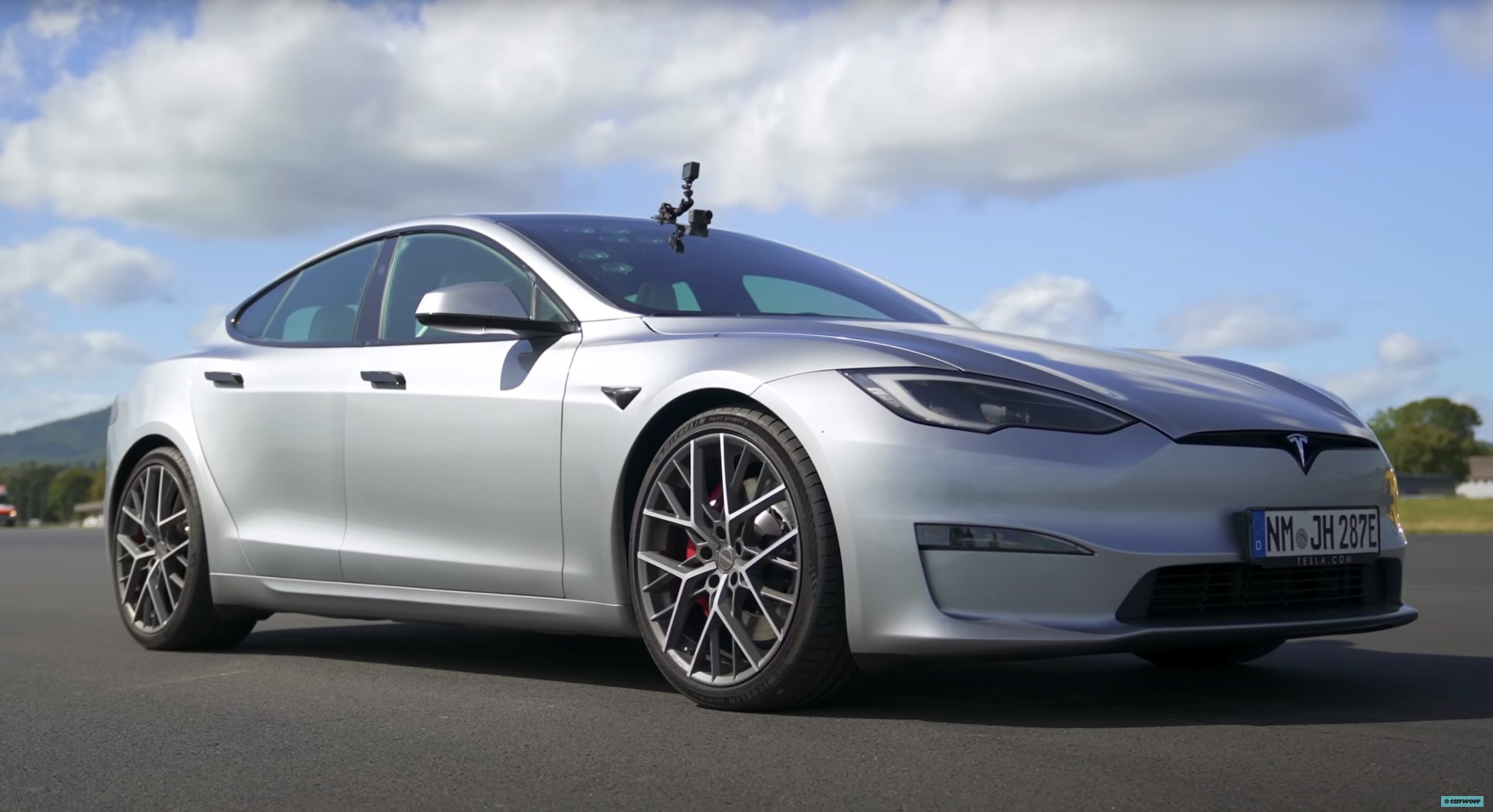
The Tesla Model S Plaid has been around for some time. Today, it is no longer the world’s quickest four-door electric sedan, nor is it the most powerful. As per a recent video from motoring YouTube channel Carwow, however, it seems like the Model S Plaid is still more than a match for some of its newer and more powerful rivals.
The monster from China
The Xiaomi SU7 Ultra is nothing short of a monster. Just like the Model S Plaid, it features three motors. It also has 1,548 hp and 1,770 Nm of torque. It’s All Wheel Drive and weighs a hefty 2,360 kg. The vehicle, which costs just about the equivalent of £55,000, has been recorded setting an insane 7:04.957 at the Nurburgring, surpassing the previous record held by the Porsche Taycan Turbo GT.
For all intents and purposes, the Model S Plaid looked outgunned in Carwow’s test. The Model S Plaid is no slouch with its three motors that produce 1,020 hp and 1,420 Nm of torque. It’s also a bit lighter at 2,190 kg despite its larger size. However, as the Carwow host pointed out, the Model S Plaid holds a 7:25.231 record in the Nurburgring. Compared to the Xiaomi SU7 Ultra’s record, the Model S Plaid’s lap time is notably slower.
Real-world tests
As could be seen in Carwow’s drag races, however, Tesla’s tech wizardry with the Model S Plaid is still hard to beat. The two vehicles competed in nine races, and the older Model S Plaid actually beat its newer, more powerful counterpart from China several times. At one point in the race, the Xiaomi SU7 Ultra hit its power limit due to its battery’s temperature, but the Model S Plaid was still going strong.
The Model S Plaid was first teased five years ago, in September 2020 during Tesla’s Battery Day. Since then, cars like the Lucid Air Sapphire and the Xiaomi SU7 Ultra have been released, surpassing its specs. But just like the Model Y ended up being the better all-rounder compared to the BYD Sealion 7 and the MG IM6, there is just something about Tesla’s tuning and refinement that makes raw specs seem not as game-changing.
Check out Carwow’s Model S Plaid vs Xiaomi SU7 drag race video below.

